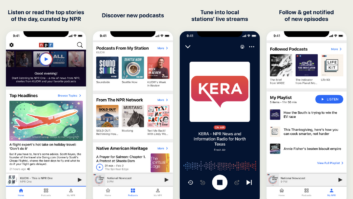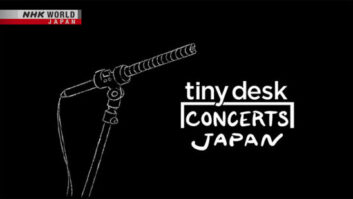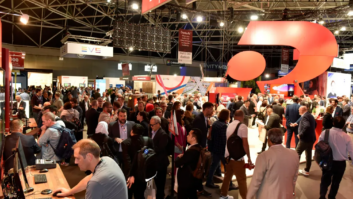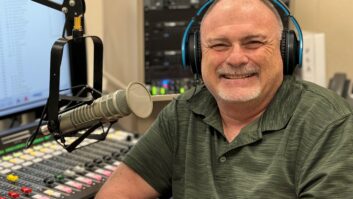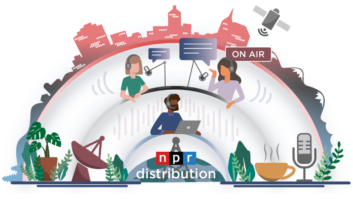(click thumbnail)NPR’s Michelle Kelemen, left, and Robert Siegel, right, pause with Russian President Vladimir Putin. Author Rich Rarey smiles at right rear.One fine day in the middle of November, Dave Argentieri, operations director at National Public Radio, stepped briskly into my office.
“The president of Russia is coming to the NPR New York bureau next week for an exclusive call-in program with us.”
My jaw dropped. “Vladimir Putin wants to talk to us?” I asked incredulously. “Yes,” Dave said, “and we should expect extreme security in New York. This program should be considered The Big Gig – there can be no mistakes and no errors.”
New York, here I come
The next thing I knew, I had been assigned to supervise the N.Y. bureau technical arrangements and technical staff for the broadcast, which was scheduled to happen in exactly a week and a day.
It would turn out to be one of the most intense and satisfying gigs I have ever had the luck to work on.
Everyone has a particular style when it comes to planning remotes. I prefer first to gather and analyze the limitations under which we have to conduct the remote.
The limitations were few and broad: Give whatever audio is required to anyone who asks.
The interview would take place at the New York bureau of NPR, on the 7th floor of a building in midtown Manhattan. The bureau has two smallish studios with associated control rooms and offices.
(click thumbnail)Neal Rauch at the Controls
NPR’s Robert Siegel would conduct the interview, accepting call-ins from regular citizens into the program. Calls would be screened and fed from NPR Washington. Siegel would select which one of eight callers on hold to put on the air.
I would have to connect a laptop with an analog modem to control the call screener hardware in Washington.
Further, two translators would be required in New York: one English-to-Russian translator provided by President Putin and a Russian-to-English translator hired by NPR.
A total of five audio sources, blended into five headphone mixes, plus an air feed of only the four voices would be sent to NPR in Washington for broadcast (read: mix number six).
More mixes
In addition, Russian television required an audio feed, as did an American TV crew. Also, the Russian print and radio media wanted a Russian-only audio feed. That meant adding a seventh, eighth and ninth mix.
I was told that I would have to provide a video camera feed from the interview studio, which would feed a video monitor in the translators’ studio.
The Russian and American security agents also required video to three more locations within the N.Y. bureau to observe the interview participants, along with a Russian-only audio feed through speakers at those three locations.
To ensure enough bandwidth to stream a video for the NPR Online Division, I needed to mount and install two Web cameras in the studio, confirm their IP address, configurations and placement prior to the security sweep on day of broadcast. I also needed to record the video feed for NPR Online to stream out later.
A dedicated audio path was needed between NPR Washington and NPR Control Room 2 in New York. Putin’s press advance person, Dimitri Peskov, (department chief of the Press Service of the president of the Russian Federation), requested two analog cassettes be produced as well, which would be taken immediately after the interview.


Getting it right
After reviewing my scribbled notes, I was able to scribble Table 1.
I’ve annotated the mixes that were “sprung” on us – we planned for the mixes we knew we had to generate, and only suspected there’d be more.
Once gathered, the limitations started to break down when analyzed: Putin and Siegel in New York would have to be in the larger Studio 2. Siegel’s headphone mix would need almost identical sources at the same mix level as the broadcast mix we would send to NPR Washington.
A few buttons on the Wheatstone console in N.Y. bureau Control Room 2 accomplished that.
Control Room 1 would be the headphone-and-special-mixes room, in addition to watching over the two translators in N.Y. Studio 1 and steering the remote-controlled video camera.
Analyzing the Russian requirements showed that five destinations would be served if those requesting the Russian mix could also hear what President Putin was hearing. Not surprisingly, everyone thought that would be just dandy.
That left two headphone mixes for the translators and two mixes for the American camera crew – one of which we knew about, the other we found out about the day before the broadcast.
In the site survey taken a week before the broadcast, we realized we would need a temporary console lash-up that could satisfy the number of separate mixes.
Initially, I envisioned a simple Shure mixer for each feed, splitting all five sources multiple times. While that image helped visualize the big picture, such an arrangement would have been unwieldy.
Instead, I brought in one of our Mackie SR24•4 mixers. It has six prefader auxiliary sends and it is lightweight. Instead of my original thought of Shure FP22 headphone amps for amplifying custom headphone feeds – de rigueur for out-in-the-field remotes – I could exploit the installed RTS headphone system and save a bunch of cables.
Because the NPR N.Y. bureau control-room conduits were stuffed to capacity, I would have had to identify cables that would then have to be run around sound lock doors between studio and control room. It was simply not practicable to rewire existing cables for the event and still maintain other NPR production work until the broadcast.
A convenient hole under the raised floor in the Control Room 2 wall allowed us to stuff cables through to the hall adjoining Control Room 1 – so we could at least close the Control Room 2 door during the broadcast.
We spent the entire Tuesday before the broadcast just planning and replanning the technical setup.
An afternoon meeting with Russian and American Secret Service representatives clarified some of the extreme security measures they would take to ensure Putin’s safety for the broadcast.
I asked the U.S. agent what would occur if something really bad were to happen.
“Just get out of our way,” he said. “There’ll be a lot of shouting, but just stay out of our way.“
Seeing my face pale, he added with a slight smile, “It’s not like in the movies – so you won’t have to worry.”
No less surprising was the revelation that Putin would arrive at the bureau earlier than we had been told.
A call was immediately placed to the executive producer at NPR Washington with this nugget of information and our broadcast was soon scheduled to start earlier.
Protocol matters
The meeting with the agents also crystallized our protocol for greeting the Russian president, all the way down to the giving of NPR hats and gifts. A Russian agent informed us that gifts would have to be screened by security and approved by the minister of protocol.
The security agents approved the locations of the closed-circuit video monitors, asked for an additional window office for their radio-relay, and identified an office as a holding room in case the Russian president decide he need to make a few phone calls in private.
Then there was the matter of the restrooms. Russian Security decided that the 7th floor men’s room was just not good enough for their president; we concurred. They decided to close it for security reasons and then secure the women’s room, which actually had a locking door.
Believe me, the technical details were the easiest items to manage after this meeting.
By the end of Tuesday, we had identified the number of cables that needed to run between the bureau’s studios and control rooms.
All the interconnections required were thoroughly planned. The installation of the in-bureau RF feeds (to be turned into video paths for monitors with the addition of a Radio Shack video DA and adapters) were finished, the video camera was staged, along with its heavy remote-control head, and the Mackie mixer prepared. All the while, the technical staff engineered two-way interviews and production mixes, doing business as usual.
Wednesday, the day before the broadcast, was surprisingly easy after all of the planning.
It took Bureau Engineer Manoli Wetherell, Bureau Tech Neal Rauch, Shop Engineer Dennis Coll and I five hours to stuff cables, plug together, complete and test every aspect of the technical plan.
Best resources
I can attribute this speed to an excellent crew and doing a remote at a site that has a good infrastructure. The N.Y. bureau’s existing facilities include an SAS crosspoint, which exposed a number of useful sources and destinations, including all four audio paths to and from NPR Washington. Distribution amplifiers were already in place, making distribution easy. A distributed data, RF and telephone system and basic pieces, such as recorders, tie lines and video monitors, were already in place.
We brought in Crown AHS111 headset microphones for the two translators in Studio 1 and cabled the mics to individual Whirlwind 1×2 splitters, one leg feeding the Mackie mixer, the other connected into a new multi-pair cable slung through the wall adjacent to Control Room 2.
These mic-level feeds brought the translators’ voices to the broadcast mix position by snaking through the hole under the floor in the control room and plugging into the studio’s XLR inputs. (It was deemed impractical to rewire the Wheatstone’s DB-25 input connectors to get these translator mics into that console.)
Split ends
We quickly found that any split left unterminated made a good radio-receiving antenna in mid-town New York. Line-level inserts of Siegel’s and Putin’s microphones were sent to Control Room 1 by existing tie lines. This brought their voices back to generate the headphone and recording mixes.
The Mackie SR24•4 was perched carefully upon C-cell battery boxes on top of the Wheatstone console in Control Room 1. The main fader bus became the feed for Putin’s headphones, and the basis for all other “Russian-only” feeds.
By substituting Control Room 1’s normal console distribution with the Mackie mixer, I moved the desired audio quickly and easily throughout the bureau.
An existing DA fed the Mackie’s Left-PGM audio to our Online Division’s video recorder, to the Tass microcassette (through a mic pad), to the Russian video crew, and to the in-bureau audio monitors.
To create the other feeds, Aux 1 send was patched into the RTS headphone input for the English-to-Russian translator, Aux 2 send was patched to our Russian-to-English translator’s headphones, and Aux 3 and 4 sends were patched to Control Room 2 by tie-lines for the American video crew.
Using an existing SAS crosspoint destination, we brought the broadcast mix from Control Room 2 to the other channel of our video recorder.
We held a mock rehearsal Wednesday evening with NPR Studio 3A to test all the systems.
Peskov, the Putin advance man, arrived to inspect the quality of our headphone mixes and to approve the translators’ video monitor location in Studio 1.
No one seemed to mind that there were cables still undressed and floor panels still missing in Control Room 2. The laptop screener worked as designed and mock callers were put into the system to challenge the Studio 3A staff’s response time to hit the delay dump button.
I left the bureau that night confident in our setups.
The big day
Thursday morning, I arrived at the bureau in my grubby clothes – it was to be a full day of dressing cables and replacing floor tiles in Control Room 2. After all, it would be an international incident if the president of Russia stepped into a hole in the floor while walking into the studio.
Manoli elected to upgrade an Adtran CSU/DSU card in the transmission equipment that managed the audio channels between NPR D.C. and the bureau.
Within moments, the audio became scarred with glitches and dropouts. I had been assured that this upgrade would fix the occasional glitch, not propagate it, so minutes were spent checking downstream Prima codecs and the cables, with conference calls between NPR Telecom and Norb Gallery, remote supervisor and guru.
Manoli replaced the old card and the problems disappeared.
“That upgrade card must have some bad code in it,” someone remarked. It was not the day to have anything bad near the bureau.
The PBS video crew producer arrived at 3 p.m., inspected Studio 2 for camera positions and noted that our closed-circuit video camera was in their way.
I explained that I would be unable to get a two-shot unless I put the camera back that far.
“Why don’t you put the camera on top of the speaker in the control room and shoot through the window?” the producer suggested. “Then you’d see both Siegel and Putin easily.”
It seemed so obvious after the video professional pointed that out; that is what we did.
Neal Rauch was selected to make the N.Y. bureau broadcast mix, Manoli Wetherell was to oversee the seven headphone and recording mixes, and Chris Tsakis was to tend the remote-controlled video camera and the recorders.
At 5:50 p.m. Secret Service agents arrived with their team and bomb-sniffing dog. As instructed, we cleared out of the bureau and milled about the 7th floor hallway. Our contact agent gave me several stamped badges to distribute to those needing close access to Putin.
Without a badge one could not get closer to Putin than the length of an agent’s arm. Then our contact agent told me to come inside the bureau to assist in the security sweep.
I was instructed to tag along with the agent he specified and point out anything that I did not recognize. We combed the bureau with the agent lifting our mostly empty shipping cases.
I asked how he could tell if it was dangerous. He said easily, “Explosives have a certain weight to them.”
When the security sweep concluded at 6:45 p.m., our engineering team made another survey of all systems. Headphone mixes OK; broadcast mix OK; ISDN backup connection OK; video crews plugged in and ready; laptop screener software finally communicating (when in doubt have someone reboot the computer at the other end); closed-circuit video and audio OK; and the most important item of the moment: The catered food had arrived.
Getting comfy
Nibbling on sandwiches and snacks intended for the coming dignitaries helped keep the engineering team focused while we awaited President Putin’s 7:45 p.m. arrival.
An almost surreal calm surrounded the bureau at this point. We milled about while the Secret Service and Russian agents spoke meaningfully into their wrist microphones.
The broadcast began from NPR Washington at 7:30 p.m., with host Neal Conan conducting interviews from NPR Studio 3A. The program was designed to simply continue from Washington until we gave the “go” sign from the bureau.
We were not particularly worried about timing Putin’s arrival, as the program was scheduled to run until 9:30 p.m. Nor were we worried about being bypassed, as we tracked Putin’s progress at “ground zero” through regular updates from the Secret Service.
Although I knew the tension level at NPR Washington was rising exponentially, I did my best to shield the bureau from that needless worry. At 8:15 pm., we received word that Putin had arrived outside, and would be coming up an elevator within two minutes.
I called “places everyone” and the engineering team took their posts. NPR President Kevin Klose stood in the bureau’s reception area, waiting to be the official greeter. Then, as if a cyclone had blown in, a gaggle of dark-suited agents whisked the bureau’s door open and produced the president of the Russian Federation.
Kevin Klose warmly greeted the president in Russian and conducted him to the studio, while Russian photographers snapped photos and security agents eyeballed everyone. Chris Tsakis made a beeline for Putin’s translator and hustled him into Studio 1.
I stood in Studio 2, under the assumption that I could describe the finer points of the Cough button and Neumann U87 mic technique to the Russian president, but I might as well have been elsewhere.
Peskov murmured and gestured to Putin, and Putin murmured back acknowledgement. Peskov had been instructed earlier on how the U87 would sound best, and we had removed the clunky mic boom arms in favor of heavy Atlas desk stands for easy positioning.
I had no further tasks in Studio 2, so I went to check the translators. I walked into Studio 1 to find things in slight disarray; President Putin’s translator was wiping down his suit, his chair and the studio table from a spilled glass of water.
Seeing that the man knew how to dry himself off, I went back to Control Room 2, to see how the sound checks were coming. Meanwhile, NPR Washington was squawking up the communications line, getting anxious to toss the program to the NPR N.Y. bureau.
Once all four participants got their headphones on, Robert Siegel made small talk that was translated into Putin’s headphone. Manoli adjusted her seven mixes in Control Room 1, Neal adjusted his broadcast mix in Control Room 2, and we gave a verbal high sign to NPR Washington.
Host Neal Conan tossed the program to Robert Siegel, and we were finally on the air at around 8:30 p.m.
Fantastically boring
Once our broadcast began, I had nothing, absolutely nothing to do.
The engineering staff performed beautifully, Rauch ducking the Russian under for English translation in complete synchronization. If only television audio could sound this good.
I wandered between Control Room 1 and Control Room 2 looking for problems. There simply were none. In a way it was a fantastically boring moment. No glitches, no faults, no dead air – no problems.
The program was stimulating, the callers delightful, the Russian president charming and Robert Siegel in top form.
After 45 minutes, Peskov gave us the five-minute warning. The president had to leave to meet with U.N. Secretary-General Kofi Annan.
Siegel began his final question, Putin answered, and almost immediately the president was whisked out the studio.
“Time for family photos,” called Peskov. All of the NPR staff posed with Putin. Cameras clattered, then after brief pleasantries, the entire security detail surrounded Putin and spirited him to the elevator.
It was a cyclone in reverse. Moments later the bureau was quiet and we were left slightly breathless, basking in the glow of “the perfect gig.”





